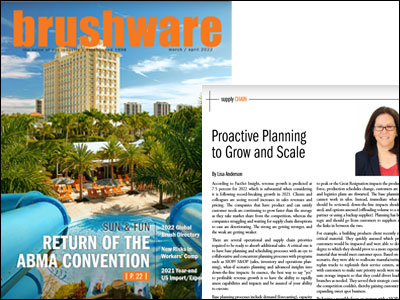As originally published in Brushware Magazine on March-April, 2022
According to FactSet Insight, revenue growth is predicted at 7.5% for 2022 which is substantial when considering it is following record-breaking growth in 2021. Clients and colleagues are seeing record increases in sales revenues and pricing. The companies that have product and can satisfy customer needs are continuing to grow faster than the average as they take market share from the competition whereas the companies struggling and waiting for supply chain disruptions to ease are deteriorating. The strong are getting stronger, and the weak are getting weaker.
There are several operational and supply chain priorities required to be ready to absorb additional sales. A critical one is to have base planning and scheduling processes with an eye to collaborative and concurrent planning processes with programs such as SIOP/ S&OP (sales, inventory, and operations planning), what if scenario planning and advanced insights into down-the-line impacts. In essence, the best way to say ‘yes’ to profitable revenue growth is to have the ability to rapidly assess capabilities and impacts and be assured of your ability to execute.
Base supply chain planning processes include demand (forecasting), capacity (machinery, equipment, resources, suppliers, storage, transportation), production, inventory, replenishment, material, and logistics planning. Read our supply chain planning category blog articles for best practices. People in these positions are often seen as analyst level and are underappreciated given the gravity of the impact on the ability to successfully grow and scale. Clients start to appreciate the relevance of these processes as the strategic aspects are incorporated with SIOP and IBP (integrated business planning processes). As executives realize that when they create a predictable revenue forecast (at a product or customer group level) and determine the best and most profitable way to fulfill it, their service levels increase, lead times decrease, profitability and efficiencies soar, working capital accelerates, and team engagement increases, their interest is peaked.
It is no longer enough to plan in a bubble. As supply chain disruptions occur, material shortages and extended lead times impact production schedules. As COVID causes absence rates to peak or the Great Resignation impacts the production workforce, production schedules change, customers are prioritized, and logistics plans are thwarted. The base planning processes cannot work in silos. Instead, immediate what-if scenarios should be reviewed, down-the-line impacts should be evaluated, and options assessed (offloading volume to a supply chain partner or using a backup supplier). Planning has become strategic and should go from customers to suppliers and include the links in between the two.
For example, a building products client ran out of a critical material. They quickly assessed which products and customers would be impacted and were able to determine the degree to which they should pivot to a more expensive alternate material that would meet customer specs. Based on this what-if scenario, they were able to reallocate manufacturing resources, replan trucks to replenish their service centers, adjust orders with customers to make sure priority needs were met, and evaluate storage impacts so that they could divert loads to nearby branches as needed. They served their strategic customers when the competition couldn’t, thereby gaining customer loyalty and expanding sweet spot business,
By having a monthly focus on the strategic with a SIOP process, the executive team is agile and able to pivot quickly with changing customer needs and end-to-end supply chain impacts. In addition, by focusing on a solid planning base, the right product is delivered at the right location at the right time at the right profit margin. The strategic and tactical are constantly realigning, optimized and in sync. The strong grow and scale, and the weak shrink.



